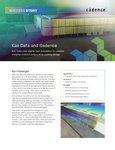Cadence Design Systems has launched a new data center digital twin platform it says will help developers and operators make data centers more energy efficient.
The company this week announced what it described as “the industry’s first comprehensive AI-driven digital twin solution” to facilitate sustainable data center design and modernization.
The Cadence Reality Digital Twin Platform will reportedly improve data center energy efficiency by up to 30 percent by virtualizing the entire data center and using AI for high-performance computing (HPC) and physics-based simulation.
The platform has modeling capabilities that can simulate a range of design scenarios to identify the most energy-efficient solutions unique to each data center – parameters include external physical forces that impact data center operation, such as airflow, wind speeds, building obstructions on air intake, and complications from internal and external temperature changes.
It evaluated multiple cooling systems and their impact on energy consumption and delivers automated reports tailored to the specific requirements of each project – including an understanding of potential energy savings and efficiency improvements.
“As data centers face increasing pressure to prioritize sustainability and energy efficiency in the face of exponential AI growth, the Cadence Reality Digital Twin Platform will optimize every aspect of data center design and operations, improve energy efficiency, and pave the way for a more efficient, resilient and environmentally friendly future,” said Tom Beckley, SVP and GM, Custom IC & PCB Group, Cadence.
Named customers include HPE and Kao.
Pascal LeCoq, worldwide director, sustainable data center modernization at HPE, said: “HPE incorporates leading-edge technologies, like the Cadence Reality Digital Twin Platform, to help drive energy efficiency, optimize capacity, and reduce carbon footprints for customers.
"We’ve had many instances of customer success, including helping to enable a Tier IV-certified colocation provider to guarantee competitive energy costs while meeting its service-level objectives, improving its environmental performance, and reducing its carbon-equivalent emissions.”
Paul Finch, CTO of Kao Data, added: “The Cadence Reality Digital Twin Platform has been instrumental in helping us make better, more informed decisions for our business and clients.
"We extensively modeled our Harlow Data Center Campus within their design software to evaluate an innovative cooling design that prioritized energy efficiency, developing the UK’s first wholesale colocation data center without mechanical cooling. Additionally, Cadence’s Reality Digital Twin Platform has enabled us to accommodate clients’ requests for high-density/AI-driven workloads.”
Nvidia creates a digital twin for Blackwell cluster
The platform is integrated with Nvidia’s Omniverse rendering platform, which brings OpenUSD data interoperability and physically-based rendering to the digital twin solution. Nvidia also explained how it used the platform for its own hardware deployment.
At its GTC conference in California this week, Nvidia demonstrated a digital twin of a GB200 cluster to plan for deployment in an existing data center.
The company said the new cluster is replacing an existing cluster in one of Nvidia's legacy data centers. The replacement cluster is based on the company’s recently announced GB200 NVL72 hardware.
To start the digital build-out, technology company Kinetic Vision scanned the facility using the NavVis VLX wearable lidar scanner to produce highly accurate point cloud data and panorama photos. A physically accurate 3D model of the facility was then created using Prevu3D software was used to remove the existing clusters and convert the point cloud to a 3D mesh.
Candence’s platform was used to simulate airflows, as well as the performance of the new liquid-cooling systems from Vertiv and Schneider Electric. The integrated cooling systems in the GB200 trays were simulated and optimized using technology from Ansys, which brought simulation data into the digital twin.
“The demo showed how digital twins can allow users to fully test, optimize and validate data center designs before ever producing a physical system,” Nvidia said.
“By visualizing the performance of the data center in the digital twin, teams can better optimize their designs and plan for what-if scenarios.”







